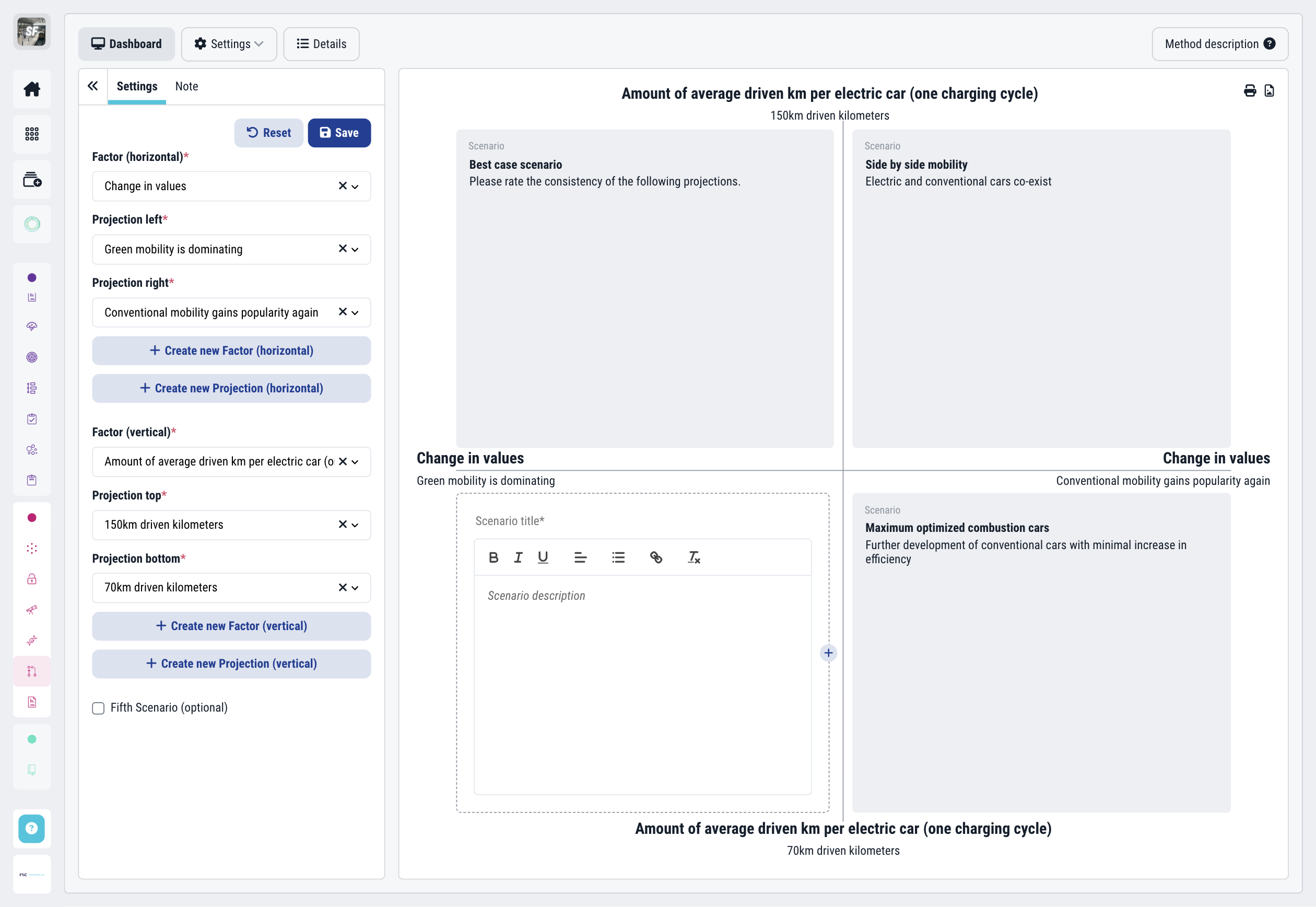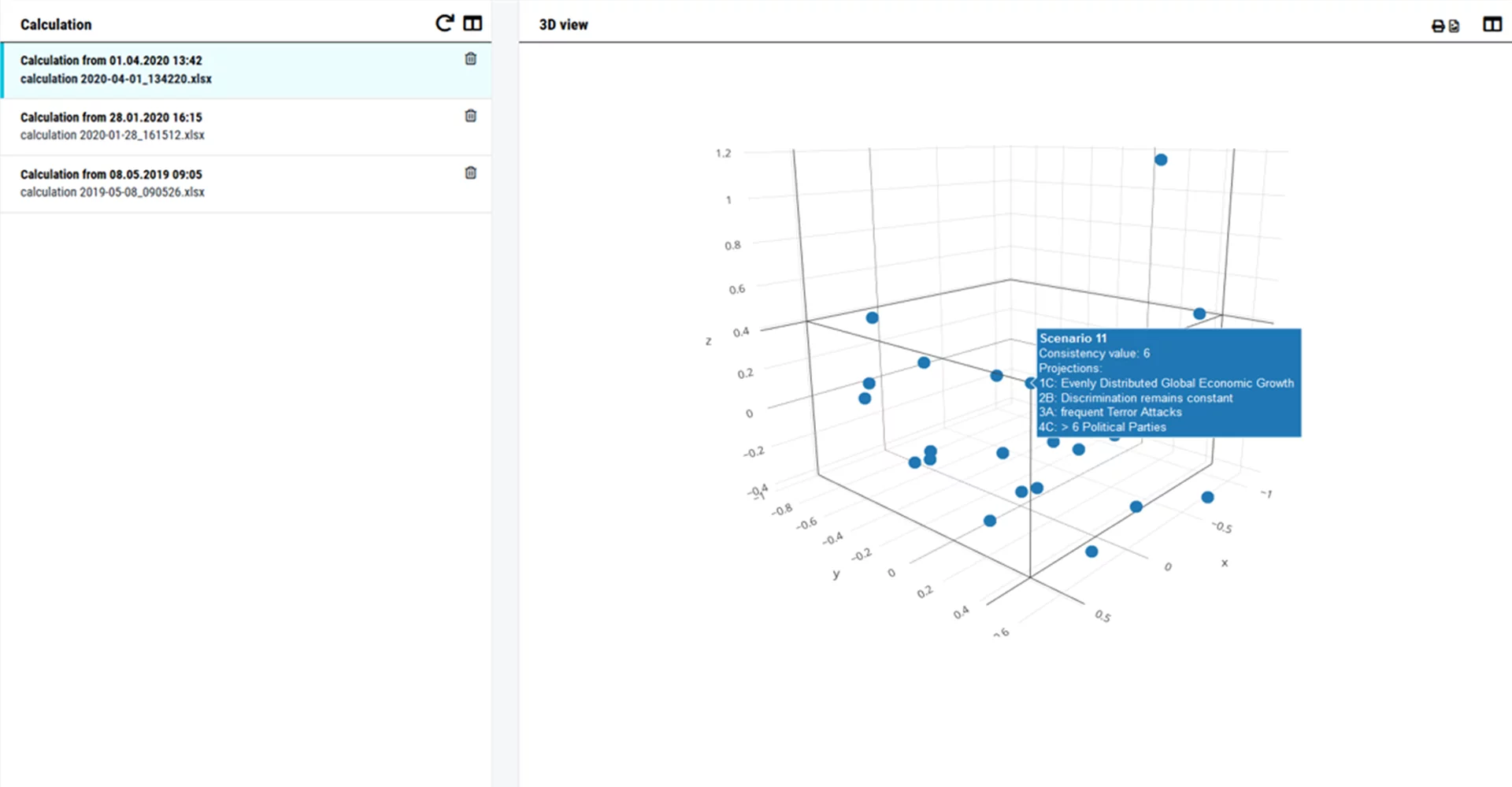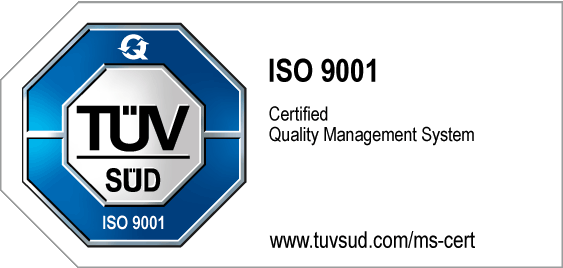Scenario Management
A scenario is a hypothetical way the future could develop and should be investigated and analysed. It is made up of a combination of projections belonging to two or more factors and described in detail.
Benefits of Trend Management Software for Companies
Structured and Consistent Methodology
Scenario management software standardizes the entire process—from factor identification and analysis to scenario development. This reduces inconsistencies and ensures that results are both transparent and reproducible.
Faster Analysis of Complex Influencing Factors
The software enables efficient collection and structuring of large amounts of data, trends, and influencing variables. This helps identify interdependencies more easily and derive robust scenarios.
AI-Supported Identification of Factors and Drivers
AI agents support the identification of relevant influencing factors by automatically scanning data, detecting patterns, and uncovering new potential drivers. This accelerates the start of the scenario process and increases the completeness of the analysis.
More Effective Team Collaboration
Shared workspaces, comment features, and collaborative evaluation processes streamline coordination among experts. This leads to better-aligned scenarios and a broader perspective.
Higher Quality in Strategic Decision-Making
Through the systematic development of alternative futures, organizations gain clearer insights into potential pathways. This supports more informed decision-making and reduces surprises in dynamic markets.
Our scenario management process
-
1Scouting for weak signalsSearch and identify weak signals, trends or other information.
-
2Derive factorsUse various methods to guide the first possible factors.
-
3Environmental scanningCheck and add your factors with the environment scanning methods.
-
4Determine key factorsIdentify factors with the strongest impact and most uncertain development process.
-
5Create scenariosCreate scenarios through the combination of factors and projections.
-
6Analyse scenariosUse various methods such as backcasting to analyse scenarios and derive your results.
-
7Communicate resultsExport, share and publish your results with the click of a button.
What Is Scenario Management?
Scenario management is based on the assumption that there is not just one future, but several possible development paths. Scenarios make these alternative futures visible by describing plausible future situations and the pathways that could lead to them.
This allows organizations to prepare early for different potential developments, mitigate strategic risks, and make better decisions in dynamic environments.
The Foresight Strategy Cockpit Scenario Management Module
Our scenario management module within the Foresight Strategy Cockpit helps you build sustainable and efficient scenario processes and continuously enhance them. Factors and scenarios can be updated at any time, linked to new insights, and integrated into your organization’s knowledge resources.
Additional features, such as automated trend scouting, simplify monitoring and ensure that your scenarios remain up to date.
AI-Supported Factor Analysis and Scenario Processes
Integrated AI agents significantly simplify the start of the scenario process: They automatically identify relevant influencing factors, formulate precise driver descriptions, and highlight emerging developments. AI supports the analysis of extensive datasets, detects patterns, and facilitates the creation of well-founded future scenarios. As a result, teams quickly gain clarity about key uncertainties and strategic levers.
Active Engagement With Possible Futures
Scenarios are created by combining different projections (variations), which—depending on the method—are assigned to two or more key factors and described in detail. The scenario management module supports your scenario planning with three established scenario construction methods: Alternative Scenario Construction, Explorative Scenario Construction, and Consistency Analysis.
Consistency analysis is especially crucial when a large number of factors and projection pairs need to be evaluated—it calculates the consistency of projections, identifies opportunities, and enables precise modeling of raw and hybrid scenarios.
Flexible Scenario Creation Without Limits
In explorative scenario construction, users can create, edit, and update factors and projections with just a few clicks—an ideal foundation for efficient scenario modeling.
In workshops, different future scenarios can then be developed, described, and jointly evaluated by combining relevant projections. This results in flexible, practice-oriented planning that provides valuable insights into possible future developments.


Fast and Simple: The Alternative Scenario Construction
In alternative scenario construction, two factors with two extreme projections each—best-case and worst-case—are placed in a four-quadrant matrix.
This foresight tool enables clear and structured scenario modeling, in which each factor-projection combination is described and four solid scenarios are derived. Additionally, a wildcard can be added as a fifth scenario to consider further contingencies early on.
Reliable Scenarios Through Collaboration
Consistency analysis is a powerful method for developing coherent and plausible future scenarios and serves as a key foundation in scenario planning. All relevant organizational members can collaboratively evaluate projection pairs, creating shared plans and a unified understanding of future developments. The calculated scenarios are visualized as clusters or in two- or three-dimensional space and provide reliable raw and hybrid scenarios that enhance strategic certainty.

Further features
-
Import pre-existing factors from other projects
-
Consistency Analysis
-
Link scenarios with trends, ideas, and risks
-
Manage, describe and edit scenarios
-
Visualize scenario clusters
Our values in short
-
Cooperative Scenario Management
-
Recognize opportunities and risks to adapt your strategy
-
Browser Add-on and App for faster integration of relevant pieces of information
-
Automated Reporting functions for fast communication
-
Fully supported and trained by our Foresight experts
Designed for your team to create futures
Summary
Scenario management techniques allow you to combine assumptions about positive and negative developments of individual factors into comprehensive future scenarios, forming a solid basis for scenario planning. This enables the creation of plausible models that help companies systematically prepare for multiple potential future paths.
In practice, this means analyzing potential impacts of future developments and deriving resilient decisions. This strategic foresight provides clarity regarding strategic options, helps identify opportunities and risks early on, and strengthens organizational integrity.
Good scenarios are plausible, often novel, and deliberately challenging—and that is exactly what makes them valuable: They open new perspectives that can be thoroughly examined and integrated into existing structures.
By embedding scenario work into internal processes, organizations can systematically prepare future decisions. Since scenario management makes the potential impacts of crises, technological shifts, or market changes visible, strategies can be reviewed, refined, and adapted to changing conditions in a timely manner.
Frequently asked questions and answers
Scenario management software is a digital platform that helps organizations create, analyze, and monitor different future scenarios with just a few clicks. It offers high usability and enables users to develop plausible future models and evaluate them strategically based on a central database.
With 4strat’s scenario management software, you can model a wide variety of “what-if” scenarios to test the resilience of existing strategies against unexpected events and changes—a key advantage for modern, future-focused management.
4strat’s scenario management software is designed to help organizations create, analyze, and continuously refine future scenarios—efficiently, collaboratively, and AI-supported. Our platform combines modern methodology, integrated knowledge resources, and intelligent AI agents to elevate your scenario processes.
Key benefits include:
Identify weak signals and trends: Automated trend scouting keeps you updated on emerging developments, market shifts, and relevant influencing factors. The software helps you identify opportunities and risks early.
Work flexibly and efficiently: Use a variety of scenario construction methods—Alternative, Explorative, and Consistency Analysis—and choose the approach best suited to your needs.
Collaboratively evaluate scenarios: The integrated consistency analysis enables teams to evaluate projection pairs together, resulting in coherent, robust scenarios and a shared understanding of future developments.
Continuously update scenarios: Sustainable scenario management requires ongoing adjustments. With 4strat, factors, projections, and scenarios can be continuously updated and aligned with new insights—for maximum future resilience.
AI-supported factor analysis and scenario modeling: Our AI agents assist with automated factor identification, precise driver descriptions, and the modeling of plausible future scenarios. This saves time, adds analytical depth, and increases the quality of strategic planning.
Comprehensive support from foresight experts: Beyond the software, 4strat provides professional guidance, training, and consulting to help you unlock the full potential of your scenario planning and secure long-term competitive advantages.
Absolutely. Our tool enables seamless integration, linking, and analysis of organizational knowledge to ensure that process or strategy changes are immediately reflected. This ensures that future decisions are always data-driven and well-founded.
AI agents in scenario management software analyze what-if scenarios in real time and automatically identify key influencing factors. They answer essential questions about possible developments and their strategic impacts. This makes scenario planning more efficient, more accurate, and faster to implement.
Scenario management helps organizations respond to future market and environmental conditions and adjust their strategic capabilities. By analyzing potential influencing factors, forecasts can be created and metrics derived for different developments, enabling early identification of risks and opportunities.
Global change is accelerating. Some future developments are predictable today, while others remain uncertain. Human action can influence these developments both positively and negatively. Although the future always involves uncertainty, scenario techniques help organizations anticipate potential events and prepare for tomorrow’s competitive environment—especially when major change is on the horizon.


